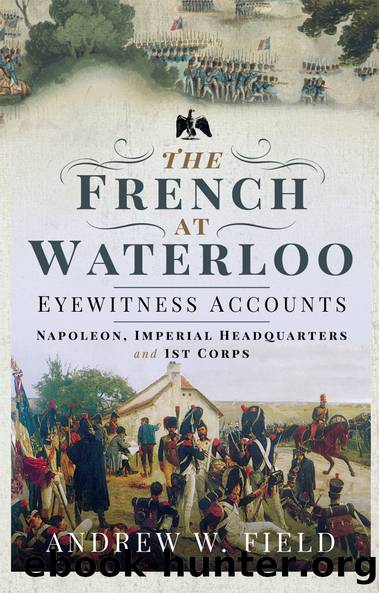The French at Waterloo: Eyewitness Accounts by Andrew W Field;

Author:Andrew W Field; [Неизв.]
Language: eng
Format: epub
Tags: History / Military / Nepoleonic Wars
Publisher: Casemate Publishers & Book Distributors, LLC
Published: 2020-07-18T20:00:00+00:00
Colonel Comte Michel Ordener
Lot, Les Deux Généraux Ordener (Paris: Roger et Chernoviz, 1910), pp. 91â5.
During the Waterloo campaign Michel Ordener commanded the 1st Cuirassier Regiment. This regiment was part of the 1st Brigade (Dubois) of the 13th Cavalry Division (Wathier St-Alphonse), part of the 4th Reserve Cavalry Corps (Milhaud). With Dubois wounded early in the battle, Ordener took command of the brigade, which consisted of the 1st and 7th Cuirassiers, and led it in the great cavalry charges.
Michel Ordener, not to be confused with his brother Antoine (who was to be killed at Waterloo), was born in 1787, son of a then maréchal des logis-chef. In 1802 he joined the 11th Chasseurs à Cheval and became a student at the Special Military School at Fontainebleau the following year. He was commissioned into the 24th Dragoons at the end of that year. In 1805, as lieutenant, he became aide-de-camp to his father who was then general, commanding the Grenadiers à Cheval of the Imperial Guard, and took part in the Austerlitz campaign. He was present at that battle where he charged with the Guard cavalry and where he won the Légion dâHonneur. The following year he became aide-de-camp to General Duroc and served with him in Prussia and Poland in 1806â7, being present at Jena, Eylau and Friedland, at which his bravery earned him promotion to captain. He served with Duroc in Spain the following year and was promoted chef dâescadron in a provisional regiment of chasseurs, then the 7th Cuirassiers in 1809. He took part in the campaign against Austria in that year and took provisional command of the regiment when the commanding officer and senior chef dâescadron were wounded and led it during the battle. Advancing with the 7th Cuirassiers into Russia in 1812, he was wounded by a lance thrust to the head at Polotsk. In November 1812 he was promoted colonel aged just twenty-five years. He commanded the 7th Cuirassiers at the crossing of the Beresina where he distinguished himself and was wounded. Named colonel of the 30th Dragoon Regiment in 1813 he was present at Lützen and Bautzen, and fought at Dresden and Leipzig. In the campaign of France in 1814, at the head of a provisional regiment, he charged at Montereau, was present at Laon and Sommesous, and was later wounded during the battle of Paris. He remained in service after the First Restoration and became commanding officer of the 1st Cuirassiers for the Waterloo campaign. He was wounded at that battle. After the Second Restoration he was put on the inactive list and did not serve again until after the July Revolution in 1830 when, for the second time, he commanded the 1st Cuirassiers. Promoted to maréchal de camp in 1831 he fulfilled less active posts before promotion to lieutenant general in 1846. He commanded several military divisions and filled inspectorate positions before being retired in 1852. He died in Paris in 1862.
Ordener gives us an interesting and detailed account of the counter-attack against Ponsonbyâs brigade and the great cavalry charges.
Download
This site does not store any files on its server. We only index and link to content provided by other sites. Please contact the content providers to delete copyright contents if any and email us, we'll remove relevant links or contents immediately.
| Africa | Americas |
| Arctic & Antarctica | Asia |
| Australia & Oceania | Europe |
| Middle East | Russia |
| United States | World |
| Ancient Civilizations | Military |
| Historical Study & Educational Resources |
Magic and Divination in Early Islam by Emilie Savage-Smith;(1462)
Ambition and Desire: The Dangerous Life of Josephine Bonaparte by Kate Williams(1286)
Bohemians, Bootleggers, Flappers, and Swells: The Best of Early Vanity Fair by Bohemians Bootleggers Flappers & Swells- The Best of Early Vanity Fair (epub)(1265)
Papillon by Henry Charrière(1265)
Twelve Caesars by Mary Beard(1148)
Operation Vengeance: The Astonishing Aerial Ambush That Changed World War II by Dan Hampton(1113)
What Really Happened: The Death of Hitler by Robert J. Hutchinson(1076)
London in the Twentieth Century by Jerry White(1054)
Time of the Magicians by Wolfram Eilenberger(1031)
Twilight of the Gods by Ian W. Toll(1027)
The Japanese by Christopher Harding(1025)
Lenin: A Biography by Robert Service(986)
The Devil You Know by Charles M. Blow(935)
Freemasons for Dummies by Hodapp Christopher;(891)
A Social History of the Media by Peter Burke & Peter Burke(885)
Napolean Hill Collection by Napoleon Hill(861)
The Churchill Complex by Ian Buruma(860)
The Rise and Triumph of the Modern Self by Unknown(855)
Henry III by David Carpenter;(854)
